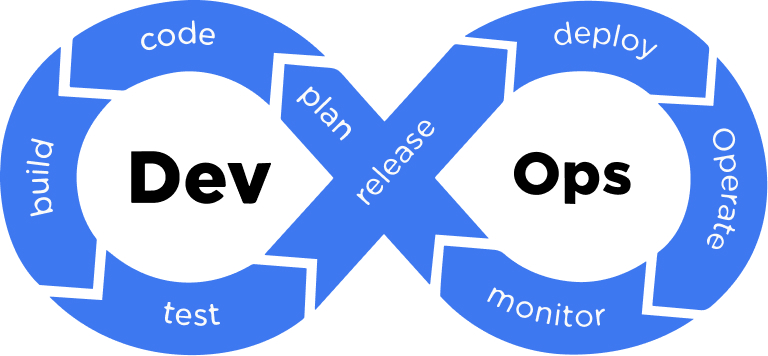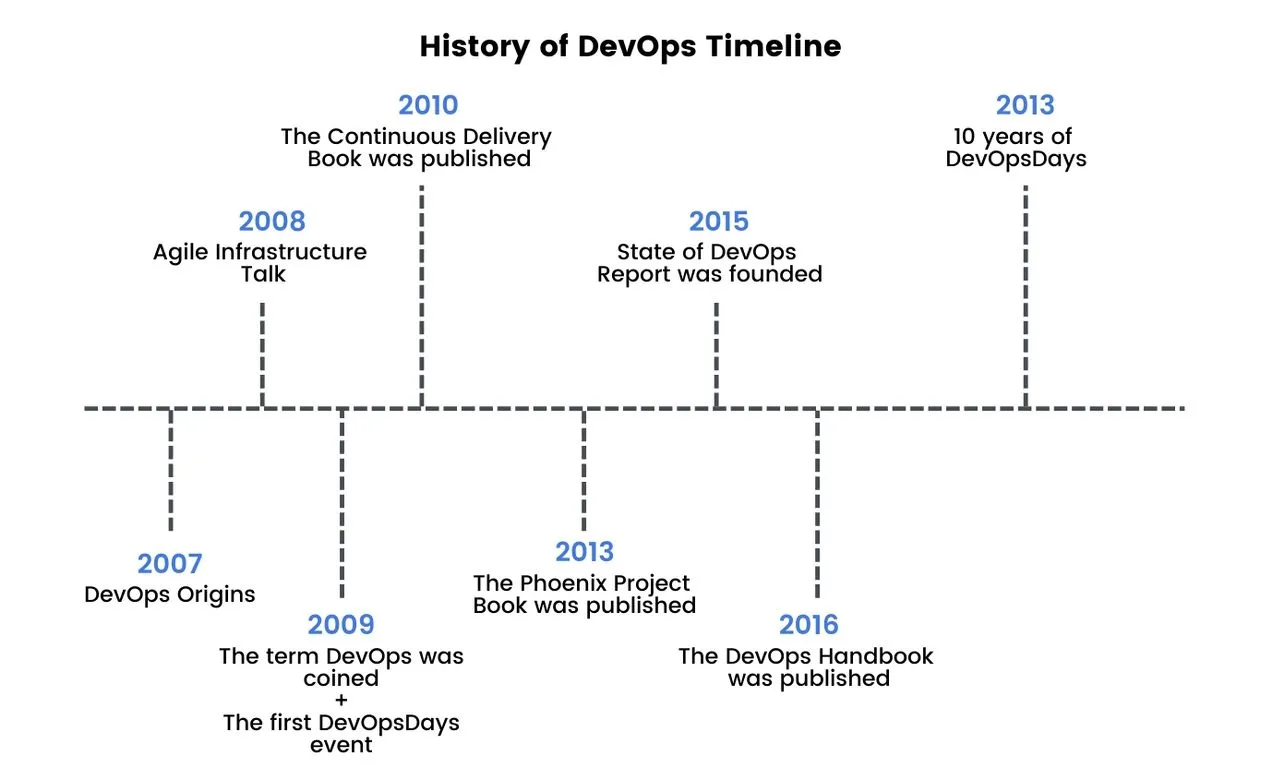The hectic pace of modern life and rapidly changing market demands force businesses to look for more efficient and less time-consuming ways to deliver value to their clients. DevOps has emerged to supply this need and provide superfast delivery of software products, features, or updates — all with decent levels of quality and security – by breaking down barriers to efficient cooperation between software development and operations teams.
This practice or rather philosophy has become a real mainstream. Many companies have already implemented it, others have an intention to do it. If you identify yourself with the latter, stick around to find out more about DevOps, its principles, practices, challenges, and benefits.
Understanding DevOps
We offer to start with the DevOps definition. As you may guess, DevOps stands for development and operations and suggests a merger between corresponding teams as well as their communal effort throughout software planning, development, deployment, operation, and ongoing monitoring.
In comparison with the traditional approach to software development, this cross-functional practice increases the velocity, efficiency, and security of software development and delivery through close collaboration, automation, swift feedback, and iterative improvement. A shorter software development lifecycle, in turn, allows businesses to get a great competitive advantage.
The success of the DevOps methodology is based on the team’s ability to promote a culture of ownership, active collaboration, open communication, and shared responsibility for project outcomes.
The primary DevOps principles that ensure high effectiveness of software development and deployment are process automation, close collaboration and communication, ongoing improvement, and concentration on users’ needs.
DevOps suggests automated builds, releases, environment provision, testing, etc. In other words, all manual time-incentive tasks that usually slow down a product delivery process and are prone to introducing human errors should be automated. DevOps automation, i.e. the use of special tools automating repetitive tasks throughout the DevOps lifecycle is a widely-used practice.
What differentiates a good DevOps team from a brilliant DevOps team is effective collaboration and close communication. Developers and Ops specialists should combine their efforts. Today far too often QA engineers and security experts also join them creating multi-discipline teams. All of them share their tasks, concerns, and suggestions as well as plan their work together to align on business goals, success measures, and users’ expectations.
Efficient DevOps teams are continuously seeking areas for improvement from automating different tasks and processes to tracking performance metrics or implementing new ideas to shorten release time or mean-time-to-recovery. They continuously raise the bar which lets them deliver excellent results.
Highly performing DevOps teams always try to reveal what end users actually need and how to provide them with it. Therefore, a short feedback loop and the above-mentioned ongoing improvement are essential features of the DevOps philosophy.
Historical background
Before the DevOps era, software developers and ops specialists worked absolutely on a standalone basis. The fact that a department building software was entirely separated from the one that deployed and supported it raised more and more concerns within the IT community around 2007 and 2008. Many people within the industry felt that it was a fatal dysfunction causing numerous issues.
In 2009, John Allspaw, Senior VP of Technical Operations, and Paul Hammond, Director of Engineering, gave their presentation named “10+ Deploys per Day: Dev and Ops Cooperation at Flickr” at the O’Reilly Velocity Conference where they brought up the point. Still, the “DevOps” term was introduced at first by PM and agile follower Patrick Debois at the “DevOps Days” conference that was held in Ghent, Belgium, the same year. Since then Patrick Debois has been regarded as the father of DevOps.
The wide adoption of the Agile methodology, the establishment of IaaS and PaaS, and the advent of continuous integration tools reinforced the DevOps idea.
A lot of books and articles on this topic have been published. The Phoenix Project: A Novel about IT, DevOps, and Helping Your Business Win by Gene Kim, Kevin Behr, and George Spafford deserves particular attention from those who want to clearly understand DevOps capabilities.
Also, with the growth of DevOps, such giants as Google, Atlassian, GitHub, and CloudBees. have launched diverse efficient solutions aligned with the concept.
These days more and more decision-makers opt for DevOps implementation to unlock business opportunities and drive innovation.
Key DevOps Practices
There are quite a lot of DevOps practices, the implementation of which speeds up, automates, and optimizes particular stages of the SDLC helping teams create smooth processes and significantly increasing team productivity. Let's have a look at some of them:
Continuous integration is the pivotal DevOps practice of automated integration of changes into a source code. It lets developers continually merge their code changes into a major repository where builds and tests are executed. Due to this DevOps teams can very swiftly identify and handle defects, increase software quality, and reduce the time needed for validation and release of new software updates.
This DevOps practice complements continuous integration by automatically deploying code changes to one or several environments. In a CD pipeline automated builds, tests, and deployments are efficiently orchestrated as one release workflow.
To be honest, version control is one of the fundamental DevOps practices. It suggests managing code in versions. Change tracking enables easy code review and recovery. This practice also helps teams work collaboratively on an authoring code and distribute tasks between different team members. It is implemented via version control tools that give an opportunity to merge code changes in the same files, efficiently address conflicts, and quickly roll back to earlier versions if there is a need. Version control is crucial for the implementation of continuous integration and described below infrastructure as code.
This practice suggests scripting infrastructure configurations and treating infrastructure definitions as actual code that can be securely stored and versioned in modern version control tools, where developers can easily revert and review it just like a usual code. This practice also assists with automated deployments and mitigates the risk of human errors, especially when it comes to sophisticated large environments.
This is one more DevOps practice that gives an opportunity to efficiently manage and control the state of system resources including DBs, servers, virtual machines, and others. Using leading configuration management solutions, DevOps teams confidently roll out changes and track system conditions to prevent possible configuration drifts over time. When combined with infrastructure as code, configuration management lets teams operate complicated environments at scale.
Continuous monitoring implies ongoing real-time tracking of the performance and soundness of an overall software stack. It ranges from the basic infrastructure that runs the software to some high-level software components. Complete visibility is achieved by data collection and preset alerts for predetermined situations. DevOps teams should make sure that they set appropriate alerts and collect an abundance of telemetry to be able to gain insights that would help them prevent and fix issues in real time and show what needs to be improved in future iterations.
This practice refers to the regular execution of automated tests every time changes in code are made. These tests are carried out as a part of a delivery pipeline to provide faster feedback to developers on recent changes pushed to the code repository. Continuous testing fosters test automation wherever possible throughout the SDLC. This way teams can evaluate the code and product quality at each stage. Gained insights help to understand whether the software can go through a delivery pipeline.
Microservices is an architectural approach according to which software is built not as a monolith but as a bunch of smaller services that can be deployed and operated autonomously, i.e. independently from each other. Every service is responsible for particular processes and communicates with other services by means of APIs. This separation and independence of functions enable the previously mentioned CI and CD practices.
Prime Benefits of DevOps
The adoption of DevOps brings numerous benefits that let businesses become more efficient in delivering outstanding features to end-users and move ahead in highly competitive markets. Let’s get down to the nitty-gritty.
These days velocity is a crucial factor for businesses that strive to stay competitive. Those who can release updates and fix bugs faster always gain a competitive advantage. DevOps practices backed by automation give an opportunity to build, test, and deliver software at high speed, innovate for customers faster, adapt to new market demands quickly, grow rapidly, and be one step ahead of rivals.
As we know, DevOps is a culture of close and efficient collaboration between software developers and operations specialists that removes interdepartmental conflicts, dysfunctional feedback loops, and other obstacles. Developers and Ops specialists communicate closely, share multiple responsibilities, and combine their workflows. This reduces inefficiencies, boosts productivity, and saves a lot of time.
DevOps solutions are not only about speed but also about quality. DevOps practices like CI, CD, and continuous testing guarantee that implemented changes are safe and operational, which gives an opportunity to provide top-notch quality of developed software. Continuous monitoring, in turn, keeps teams informed on the performance and soundness of the product in real time.
As the number of cybersecurity threats is growing, and they become more serious, a well-thought-out and properly implemented DevSecOps strategy can strengthen the security of IT infrastructure and product security. DevSecOps, which stands for development, security, and operations, is a special approach to infrastructure design that incorporates security throughout the SDLC. It enhances the recovery speed by means of incremental improvements, automated compliance policies, configuration management techniques, and granular controls.
DevOps gives an opportunity to manage all software development processes and a whole infrastructure at scale. Thanks to consistency and automation, DevOps teams can efficiently and at a minimum risk manage sophisticated and frequently changing systems. Such DevOps practice as infrastructure as code also gives an opportunity to manage environments of all kinds in a more efficient manner.
We would like to tell you that DevOps helps to cut down expenses, but it does not. In fact, DevOps requires significant investments due to the automation of multiple processes that it suggests. However, there is good news – DevOps actually helps businesses generate higher revenue because they start to deliver more value to their clients. According to stats, on average, companies that have adopted DevOps experience a 60% growth in their revenue and profit.
The main challenges associated with DevOps adoption
DevOps is not a brand-new concept. Many companies have already introduced it or tried to do this, and the experience shows that the vast majority of them experience certain challenges. We would like to highlight the most common challenges of DevOps adoption so that you can consider them while making your baby steps in the DevOps direction.
| Resistance to change | The vast majority of people are unhappy with the prospect of changing their usual way of working – they have gotten used to their method of doing things and are usually unwilling to step outside their comfort zone, gain new skills, and adjust their usual working routine or processes. Be ready for the fact that some of your team members may prefer working in silos and may not wish to communicate with others. So there is a high probability that you will face resistance in the transformation process. Still, be patient – you cannot change people’s mindset and culture overnight. Instead, introduce DevOps as a natural evolution of your development practices and foster a company culture that encourages all teams to cooperate to deliver value to your clients. |
| Transformation into a Cross-Functional Team | Moving away from traditional expertise teams to cross-functional ones is not as easy as it may seem at first. With the DevOps adoption, your team will need to integrate all functions: frontend, backend, infrastructure, testing, maintenance, etc. To overcome this challenge you need to make a change in corporate culture. To smooth this transition you will have to invest in training and team building to fill in gaps in knowledge and improve interpersonal communication. |
| Utmost Automation | DevOps heavily depends upon automation striving to automate as many processes as possible in order to enhance productivity and ensure high quality. Consequently, DevOps is associated with the use of different tools that should be leveraged correctly to be effective. No need to say that it requires specific skills, knowledge, and expertise. |
| Choice of DevOps Tools | Challenges associated with DevOps tools relate to the abundance of tools available on the market, which makes choosing a rather daunting task. Insufficient knowledge of the tools and technology behind them also makes this choice difficult. We would recommend you engage a seasoned DevOps consultant who will see the big picture and pick up the right tools based on your project requirements and peculiarities. |
| Incomplete understanding of the DevOps meaning | Unfortunately, a lot of companies wish to get the benefits that DevOps promises but often do not invest a sufficient amount of time in its study and the design of an adoption strategy. Sometimes such companies assign this task to DevOps leaders or advocates but leave them without the support of a C-suite in terms of encouraging and nurturing the real DevOps culture. |
DevOps tools
As was mentioned above, DevOps suggests using a bunch of tools to sweeten up team collaboration, introduce automation, manage complex environments, and enable observability and real-time monitoring. In general, they help to address a particular stage of the DevOps lifecycle. We would like to present to you the leading DevOps with regard to these phases.
At this stage, it is essential to enable all team members to share and comment on ideas, goals, requirements, strategies, roadmaps, and project documentation. Such tools as Jira, Confluence, and Slack can help with this as well as with scheduling, task tracking tools, and overall project management.
At this phase, your team can use Kubernetes and Docker to provide individual development environments. It’s a well-known fact that coding against virtual, disposable reproduction of production helps to get more work done.
Puppet, Terraform, and Chef can be utilized to introduce the practice of infrastructure as code.
GitLab, GitHub, and Bitbucket are popular version control solutions that enable convenient code storage, revision, and management. Code is stored in different chains to enable users to see all changes and collaborate more efficiently by sharing them. Instead of waiting on change approval before deploying them to production, users improve code quality and throughput via pull requests, i.e. peer reviews.
Such tools as Jenkins, CircleCI, SonarSouce, and GitLab CI, can be used to implement CI/CD. They automatically apply tests to development branches in a repository and give the option to push to the main one in case branch builds are successful.
Test automation mitigates risks and enhances software quality through early and frequent test execution. Automated tests can check functionality, UI, security, performance, and other characteristics of software. Automatically generated reports and trend graphs help identify risky areas. Solutions that can be used for test automation are JUnit, Selenium, Codeception, Vagrant, TestNG, BlazeMeter, and others.
When it comes to deployment, we would like to draw your attention to Jira Software, which can be used as a deployment board. Being integrated with a code repository and deployment tools, it can provide you with full visibility on branches, changes, builds, pull requests, and deployment warnings.
Moreover, to automate your deployment, you can leverage Bitbucket and AWS CodePipeline. If this is your first time, you would better start with automating deployments to a low-level environment. Then you can repeat everything all the way up to a production environment. This way, you will have a chance to notice the differences between your environments and take measures to standardize them. By the way, standardized automated deployments mitigate the risk of “server drift” between and within environments.
This phase is all about tracking incidents, problems, and changes on a production environment. Opsgenie, Jira Software, Jira Service Management, and Statuspage are tools that enable developers and ops specialists to identify, track, and fix problems in a timely manner.
24/7 server monitoring and software performance monitoring are of utter importance for DevOps teams.
Opsgenie, Nagios, New Relic, Splunk, Sumo Logic, DataDog, and Pingdom are tools that continuously collect and record data providing teams with an ongoing observability and an opportunity to uncover trends and understand the overall health of software and environments. Being integrated with a group chat client, these tools send alerts to a team’s room or a dedicated incident room.
Conclusion
DevOps has proved to be highly efficient. Being based on close communication and collaboration, automation, ongoing improvement, and user-centricity, it brings numerous benefits including higher team productivity, better product quality, shorter time to market, business adaptivity, higher user satisfaction, higher profit, etc. If you wish to propel business innovation and drive business growth, do not hesitate to adopt DevOps culture, practices, and tools.





